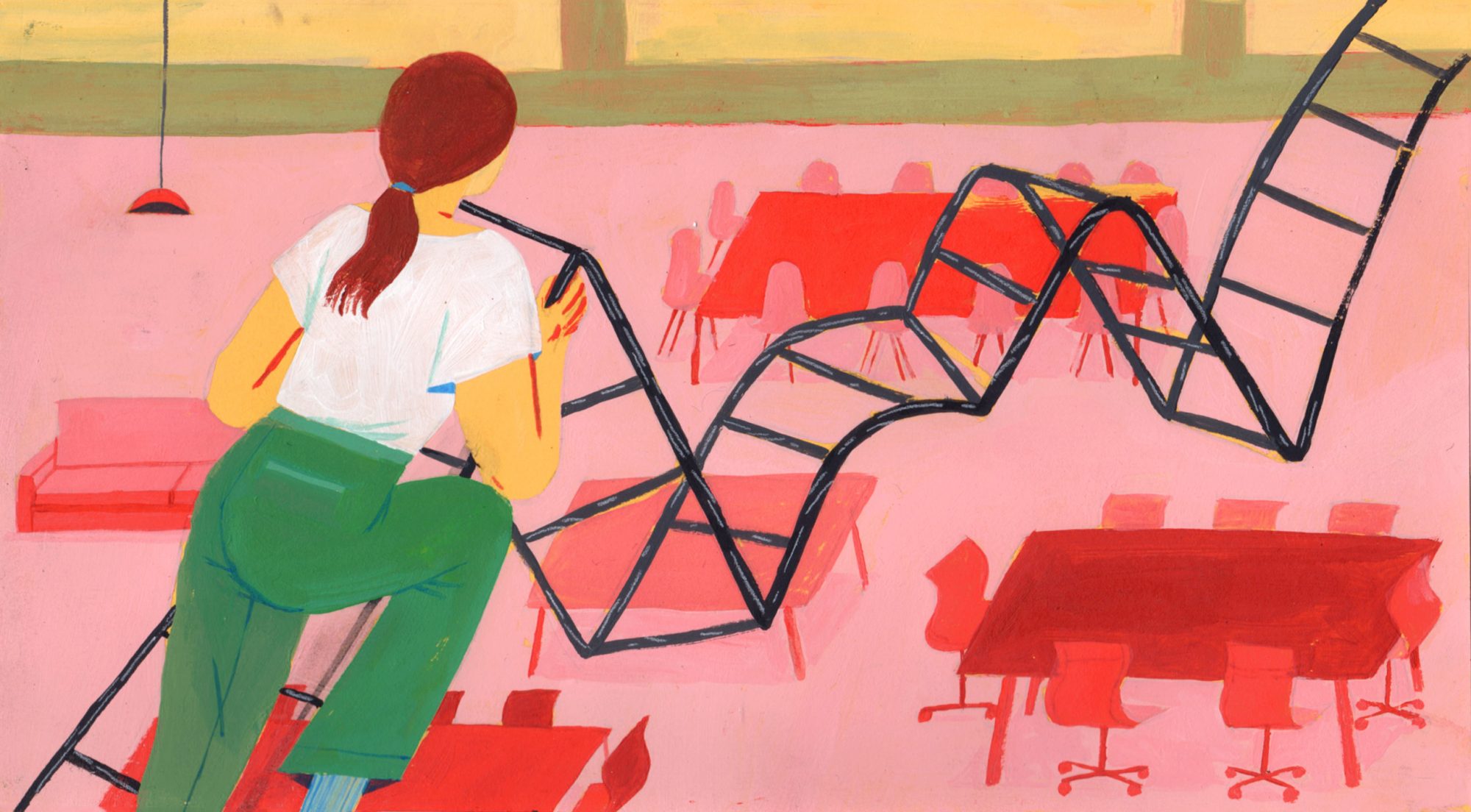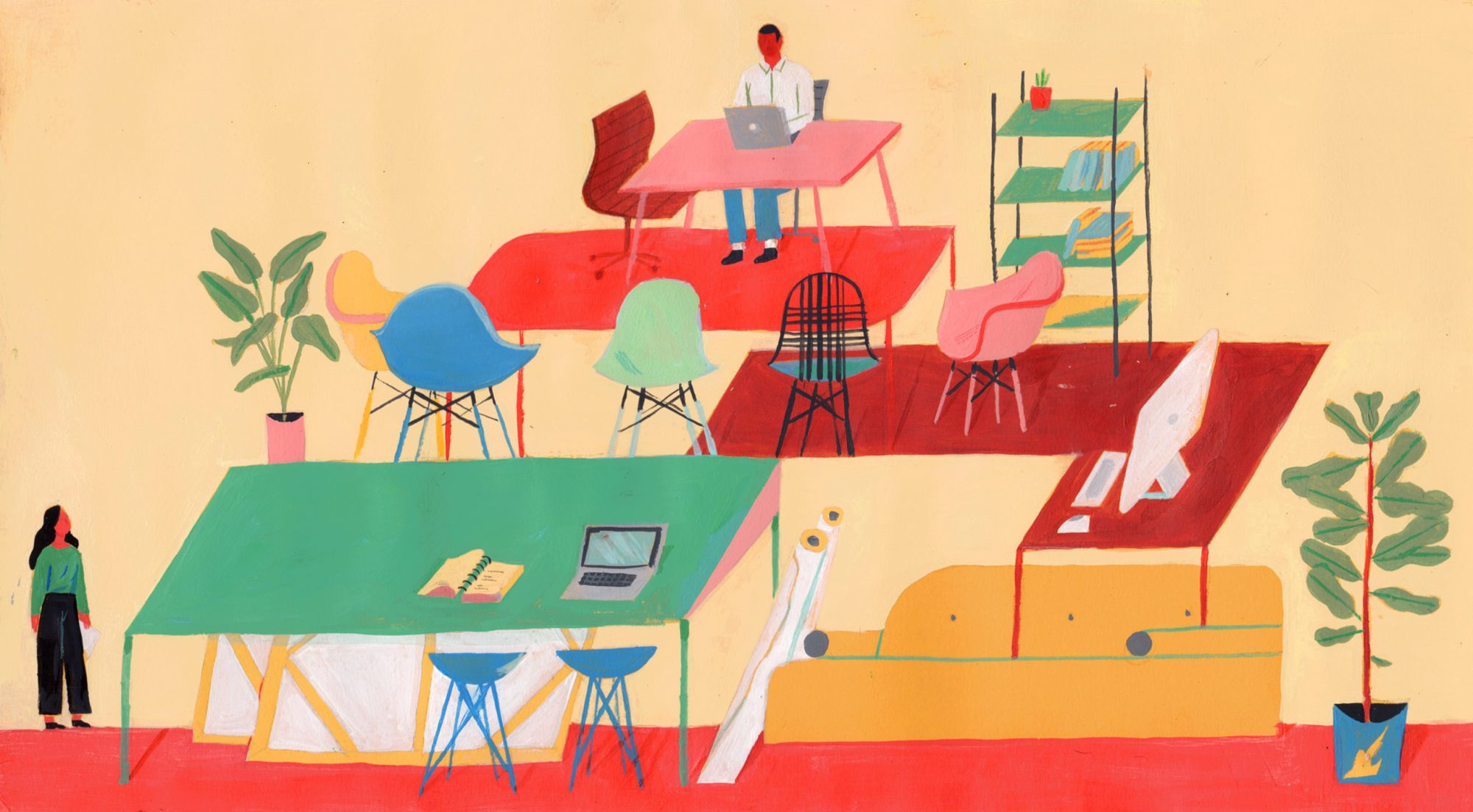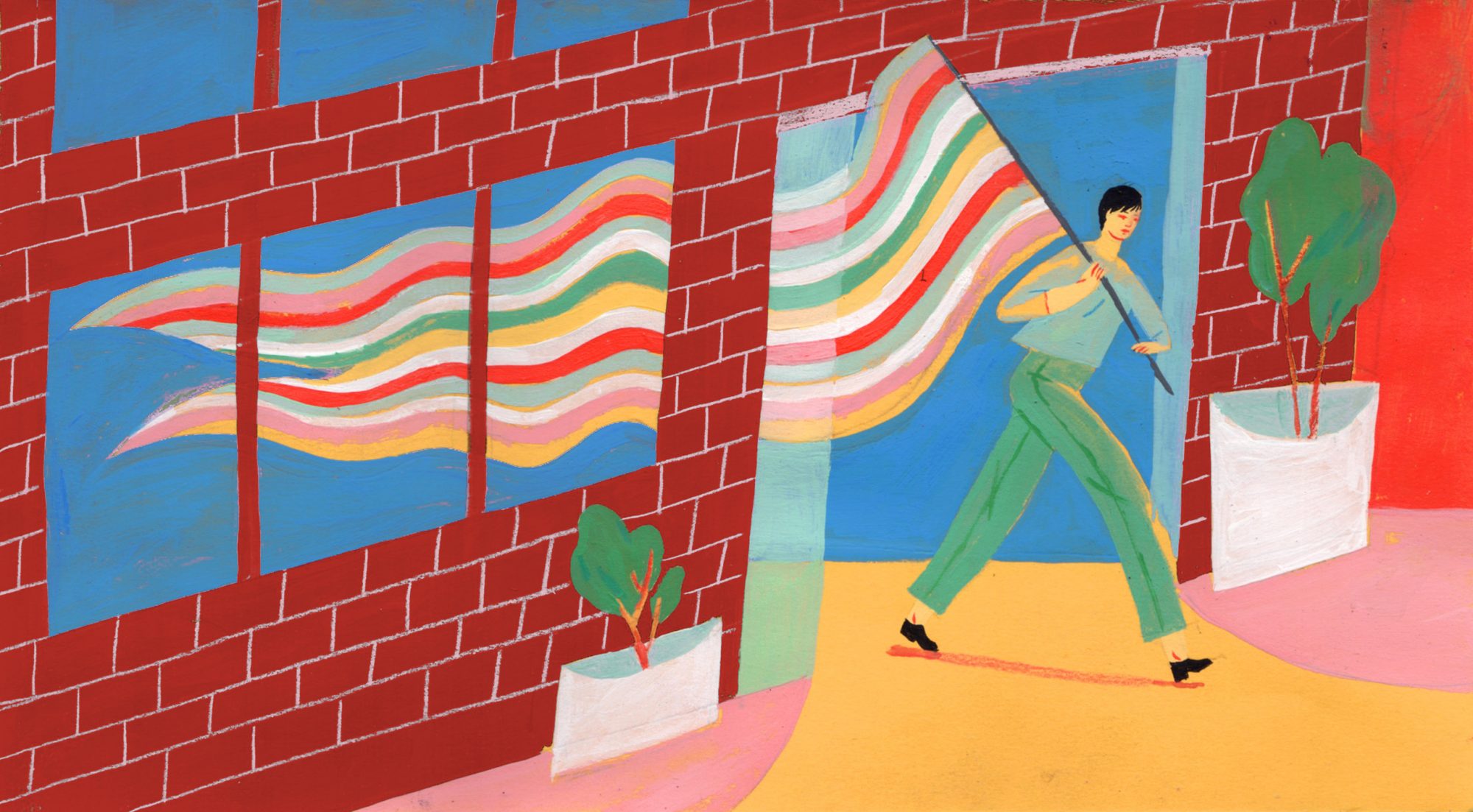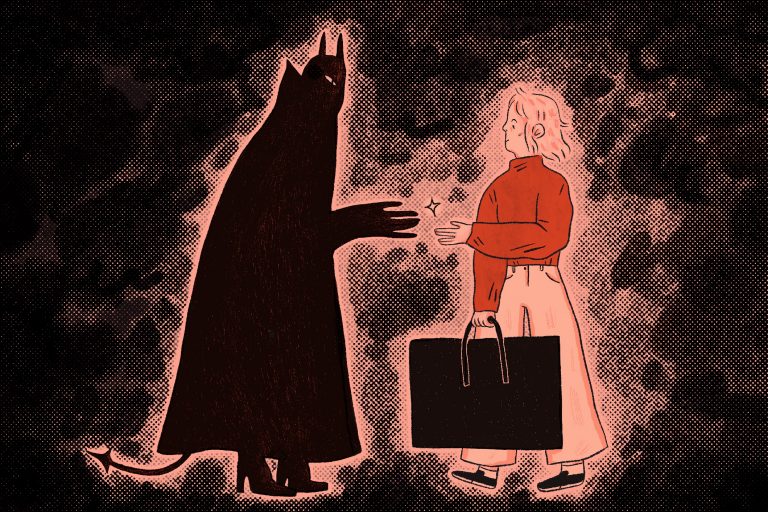
Mind the Gap
Ruby Goss draws from personal experience to launch an investigation into the gender pay gap that plagues the creative industries
Words by Ruby Goss
Illustration by Celia Jacobs
For a sector that prides itself on bringing imagination to life, the creative industry is depressingly conformist in its gender imbalance. Not only are women vastly underrepresented in creative workplaces (especially when it comes to leadership), we are discriminated against in the most insidious of ways – by the gender pay gap.
I graduated in 2015. We are supposed to be three waves into feminism. But my career began like this:
After my first internship out of university, I was offered a full-time position at a creative agency. It took months of manipulative meetings to negotiate a fair version of the contract I was offered (diversions that were no mean feat in a small company – though indirect communication on Slack, the very likely fear of public humiliation and secret building exits would all work in his favour). I was told that the company didn’t make enough to pay me more (a blatant lie) but that they really wanted to keep me on, that no one else on payroll was rolling in it, so to speak.
Humiliatingly, my life choices were questioned: Why did I even need ‘so much’? How much was my rent? Why was I paying that amount? For perspective: The wage proposed to me was below the national minimum in the country I was in. Like many young creatives I believed myself ‘lucky’ to have the role offered to me, and moreover, having saved up to ‘afford’ the cost of undertaking an internship, I wasn’t in the financial situation to make a statement by leaving (a predicament that is more-than-Alanis ‘ironic’). It was a circuitous process that relied on me to comply and to thereby undersell myself. I presumed this to be because of my youth, but I would come to understand that it was also based on my gender. Eventually, I relented – agreeing to the sum with a condition that I knew, deep down, to be a hollow clause – the promise of raise negotiation a matter of months into my contract. During these months, I found out that a male colleague was earning more than me. I felt, somehow, ashamed of myself. Had I not tried hard enough to defend myself? I attempted to confront the situation and ask for more. ‘Leaning in,’ they call it.

Months – again – passed as I tried to secure my meeting. But when the time came, I wasn’t taken upstairs to negotiate, beer in hand, to descend mid bro-out – but summoned down to the finance office. There, I presented my carefully rehearsed case as to why I ‘deserved’ more. I tried to ‘think like a man’. I dared to quote a figure I knew my male colleague to be earning. But, in his temple-throbbing response – octaves above mine – I was told that he did not care what was written in my contract, he did not care how good my work was – he wasn’t going pay me a cent more. End of. Again, I did not feel I had the luxury of leaving simply because I felt bullied and degraded – and like many young creatives, I still thought I needed to ‘do my time’.
I did not know the following figures before writing this article, but young women entering the creative industry: You will likely hit that glass ceiling before you’ve even begun your career. In 2015, the Design Council found that despite a female majority in tertiary design courses – the working industry is dominated by 78 percent male workers. This is an above average level of under-representation: across the whole working economy the figure is a lower 53 percent. And for those women who do make it – well – 68 percent of women designers are earning below the average salary in the design economy. It’s an echoing of the sad reality we know as women – that everything will take that much more grit because we are always less – less logical, less powerful, less heard, less safe and underpaid to boot.
It doesn’t even seem to matter what sector of the industry you find yourself in or where indeed you practise. The problem is systemic and it is global (with the usual exception of the Nordic nations). Australia’s irreverently titled CoUNTess Report revealed that even though women artists win more prizes than their male counterparts, they receive less prize-money and less representation in galleries. And, somehow more depressingly, is the notion that having women in leadership positions doesn’t always rectify the gap: While women dominate the arts sector in Australia, the gender pay gap in managerial positions was then greater than in any other industry. Over in the US, Pinterest’s ‘Right the Ratio’ study found that only 12% of creative directors are women. Jessica Walsh’s findings elaborated that only are 9.6% art directors and only 11.69% copywriters. Time for the final ringer: HoneyBook found not only found that men in the creative industry earn on average 32% more than women but that women creatives statistically charged less for their work.

Here’s the thing: You can’t, as my situation revealed, force someone to ‘see’ you. But the ersatz answer to our problems, Sheryl Sandberg’s ‘leaning in’, tells us that we must negotiate for higher salaries if we want to see change. To that, I ask you: How many creative positions have you seen with ‘dependent on experience’ listed where a figure should be? When was the last time you saw a call out for a freelance project with an asking price? If you’ve worked for a smaller studio (ergo, no HR department) or you freelance, chances are you have had to negotiate the grey area of salary. I’m sure wage negotiations are universally uncomfortable, but this is an especially fraught position to find yourself in as a woman, especially upon entering the industry: A Harvard study found both male and female managers are less likely to want to work with women who negotiate during a job interview. The same bravado and assertiveness that supposedly makes stellar businessmen are not things universally valued in women. The cruel double standard that we are all too aware of is the following: Be a ‘good girl’ and accommodate their proposal; be a ‘bitch’ and lose their esteem, or at worse, the job (the latter of which happened to other women who challenged the situation at my former workplace).
“Our ‘accept what we’re given’ stance is deep in the psyche of women, and often means that young women and graduates rarely negotiate salaries from the get-go, and so the gap begins. I am embarrassed to say I didn’t negotiate a single salary until I was 29. Ask around, and you’ll hear that time and again,” says Nat Maher, MD of Pollitt & Partners and founder of Kerning the Gap, a UK-based collective that advocates for women in leadership through talks and mentoring programmes.
Ask around I did. The experiences of my peers in the industry only confirm the problematic arena our wages are determined in. First there’s the inculcated sense of guilt in putting yourself first as a woman. We’re ‘supposed’ to nurture, not to lead: “The impulse to apologise for asking for more or charging “too much” is something I’ve struggled with,” says Bryn Silverman, a filmmaker from the US. “But I’ll never hear those sentiments coming from my male colleagues. I tend to ask them what they charge for the same freelance work I’ll be doing and charge that amount.” As Nat alluded to, tertiary education often fails to prepare us for industry practicalities like setting rates, nor do they provide any realistic advice for women in particular, as Bryn shares: “I wasn’t comfortable charging at all for my film work when I first started out even though I had a Bachelor’s degree from the highest ranked film school in the world. As women in film school, we didn’t get a class on how to hold our own in the film industry. Over the years, I’ve had to better understand and own my worth. I’m trying more and more not to attribute my success to luck.”

Rosie Flanagan, an Australian multi-hyphenate writer, editor and graphic designer, like Bryn, comments on our problematic conditioning to ‘think like men’. “In situations where I have had to negotiate my salary or my rate for a piece, I have been told by friends to ‘think like a man’. Though it is said laughingly, it’s recently become less and less funny. It’s difficult for women, we have to really strategise before having these meetings – and we do. Together we write the lines that we then tell our bosses. No, we are worth this amount. This is the role. This is the experience we have. We know that he gets paid more, and we want the same. These conversations are exhausting and seemingly never-ending, and I’ve only ever had them with women. We are one another’s greatest allies: No female friend or colleague has ever shied away from telling me her wage. My male colleagues have, and do. This doesn’t mean that they agree with the gap – it just doesn’t seem enough of a deal to them to warrant an argument about it. I’d like to believe that they’re ashamed that they take home more than women when they know it is not deserved, but I can’t be sure.”
We are our greatest allies. There is a growing global movement of women’s initiatives in the creative world just like Kerning the Gap (take Women, Wine and Design that crops up in 120 countries) that you can join. Along my way, I have found so much catharsis and confidence from confiding in women’s circles. We need to share our experiences, to mentor each other, to see that there are damn successful women out there – so that when we enter into negotiations it is these women we seek to emulate. Only then can we lay down that paltry rallying cry that has nothing to do with us: ‘Think like a man’. Because being a woman is enough.
But like Rosie, I’d also like to believe that men care enough too. It is frankly sad and it is tiring to think that we alone must band together to solve a situation that we had no hand in creating (not least because we weren’t allowed to). We are not the only industry with an imbalance, but are we not the industry to respond creatively to this mess? “The factors underpinning [the balance of power in the industry] are multitudinous – unconscious bias, historical lack of paternity support, sheer lack of confidence, lack of role models – but we now know that the more women we have in leadership roles, the more will rise. Equality begets equality. And we must do everything we can now to speed up the balance. We need every level, every discipline in design, and every gender to be a part of the solution,” says Nat, before elaborating on the necessity for industry-wide action from all genders. “That’s why we called it Kerning the Gap, and not ‘women in design’. Men simply have to be involved in the debate. It’s not enough to just ask women to ‘lean in’. That’s really important, but businesses have a responsibility to create environments where women can flourish too. We should know that women find it difficult to push for more pay, and act responsibly and fairly as employers, to encourage and facilitate the conversation.”

Financial discrimination does not happen in a vacuum. It is rooted in the basic equation of the value placed on women. It succeeds through the same conditions that #metoo revealed last year – white (cis, heterosexual) male entitlement and social contract of silence. As a young person entering the industry, it can be hard to navigate what ‘comes with the job’ and what most certainly should not. I defer to Cindy Gallop – an advertising legend (she usefully also exists as a chat bot on Facebook. Consult her next time you need to negotiate) and staunch advocate for women’s advancement in the creative industry. She put it simply to me: “The time to speak up is always now. And the time to leave is when your speaking up is not welcomed and acted on. You need a workplace that shares your values. If they make it clear they don’t, get the fuck out.” In my triumphant day dreams I walked out of that office where I was refused a raise – and I don’t go back. Instead, I did the next best thing, I found myself a better paid position – and I left. Typing that sentence I am struck by how easy it sounds – I know it didn’t feel like that at the time. It took fear and grit and support (from, I am proud to say, some excellent women and men as allies) but most significantly, it took its time.
There is no point attempting to ‘lean in’ – to try to be heard by someone who shows they do not value your voice. I implore you not to limit your conversations about workplace bias to palliative after-work drinks. I refuse to accept that these are the so-called ‘Media Men’ that we must endure in our line of work. They cannot be entrusted without our remuneration. We need to be a new generation in every sense and not accept being paid less – and treated as less – than the status quo. Without fresh talent, they will stagnate and their time.will.be.up. If they do not let you speak; if they do not value your work; if they do not pay what you deserve? You have to find work (or make work) that doesn’t just let you imagine a stellar career for yourself, but that – regardless of your gender – lets you create one.

This piece is the first in our four part series ‘Rigged System’, created in partnership with WeTransfer. It’s a project determined to start vital conversations about the current state of the creative industries. If we critique and challenge elements of the workplace, there’s a greater motivation for, and means of, positive change. We believe that inclusive, diverse workplaces are truly creative environments and are united in our mission to help people understand why. Mind the Gap is written by Ruby Goss, a Berlin-based writer and editor who you can – and should – reach out to here. Our illustrator is Celia Jacobs, a shining star currently residing in Los Angeles. See more of her brilliant work here. Part two of ‘Rigged System’ will be published in a fortnight.









